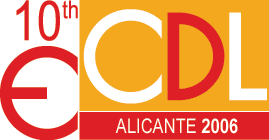
Creating a more full-featured institutional repository: Combining DSpace, ETD-db, and DigiTool.
Presenters' name:
Eric Lease Morgan (University of Notre Dame)
Abstract
DSpace, ETD-db, and DigiTool are all well-respected systems designed to facilitate aspects of an institutional repository. Each have their own particular strengths and weaknesses, but none of them are perfect. By exploiting the OAI data repository features of each system the developer is able to amalgamate their content, automatically classify it, cache it centrally, and provide sets of enhanced services against the cache. Building on the strengths of each system developers are able to provide a more full-featured institutional repository system. The primary goal of this tutorial is to outline the benefits and drawbacks of such an implementation, demonstrate how it has been implemented at the University of Notre Dame, and discuss how it can be implemented with other software components. By the end of the tutorial participants will be able to: highlight the problems IR systems are expected to solve, be able to compare and contrast three IR systems, address meta-data issues r egarding the organization of information in IR systems, state the advantages of amalgamating IR content into a centralized cache, discuss ways these same ideas can be implemented with a variety of software.
Contents
- The problems institutional repositories are trying to solve
What is an institutional repository, and what problems is it intended to solve? What qualities characterize successful institutional repository implementations? The group answers to these questions become the benchmarks for evaluating the success of repositories.
- Functional overview of DSpace, ETD-db, and DigiTool
Each of these applications have strengths and weaknesses. This section will enumerate them and in the process compare and contrast the applications.
- Developing an over-arching information architecture
In order to create a synergistic whole from the three repository applications it is necessary to apply aspects of information architecture to the systems - aspects of users, context, and content. This section will focus on the content issues and elaborate upon methods of logically organizing it using a faceted classification system.
- Using OAI to harvest content and cache it centrally
At first, this seems like the easy part. Point your harvester at the repository and save the output locally. After a bit of examination, issues regarding homogeneity and variations in OAI compliance come into play and adjustments need to be made. This section describes some ways to address these issues.
- Creating user-centered services against the cache
This is the fun part. Here we provide services against the cache. Searching (via SRU). Browsing. What's new? services. Syndicating content to campus portals. Syndicating content via RSS. Creating dynamically generated Web pages listing author publications. Calculating Google page rank. Each of these things will be described in more detail.
- Discussion of other ways the same things could be implemented
The implementation of Notre Dame uses specific tools to accomplish its goal. By exploiting protocols, not specific applications, these tools could easily be changed out for other tools. This section discusses these issues and provides an opportunity for participants to brainstorm other ways these techniques could be employed in their institution.
Copyright ECDL - Design by JASBAT
